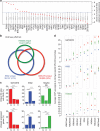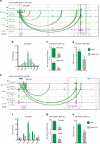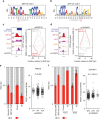ZNF143 provides sequence specificity to secure chromatin interactions at gene promoters
- PMID: 25645053
- PMCID: PMC4431651
- DOI: 10.1038/ncomms7186
ZNF143 provides sequence specificity to secure chromatin interactions at gene promoters
Erratum in
-
Publisher Correction: ZNF143 provides sequence specificity to secure chromatin interactions at gene promoters.Nat Commun. 2018 Apr 10;9:16194. doi: 10.1038/ncomms16194. Nat Commun. 2018. PMID: 29633758 Free PMC article.
Abstract
Chromatin interactions connect distal regulatory elements to target gene promoters guiding stimulus- and lineage-specific transcription. Few factors securing chromatin interactions have so far been identified. Here, by integrating chromatin interaction maps with the large collection of transcription factor-binding profiles provided by the ENCODE project, we demonstrate that the zinc-finger protein ZNF143 preferentially occupies anchors of chromatin interactions connecting promoters with distal regulatory elements. It binds directly to promoters and associates with lineage-specific chromatin interactions and gene expression. Silencing ZNF143 or modulating its DNA-binding affinity using single-nucleotide polymorphisms (SNPs) as a surrogate of site-directed mutagenesis reveals the sequence dependency of chromatin interactions at gene promoters. We also find that chromatin interactions alone do not regulate gene expression. Together, our results identify ZNF143 as a novel chromatin-looping factor that contributes to the architectural foundation of the genome by providing sequence specificity at promoters connected with distal regulatory elements.
Conflict of interest statement
The authors declare no competing financial interests.
Figures





Similar articles
-
Putative looping factor ZNF143/ZFP143 is an essential transcriptional regulator with no looping function.Mol Cell. 2025 Jan 2;85(1):9-23.e9. doi: 10.1016/j.molcel.2024.11.032. Epub 2024 Dec 20. Mol Cell. 2025. PMID: 39708803 Free PMC article.
-
Genomic Determinants of THAP11/ZNF143/HCFC1 Complex Recruitment to Chromatin.Mol Cell Biol. 2015 Dec;35(24):4135-46. doi: 10.1128/MCB.00477-15. Epub 2015 Sep 28. Mol Cell Biol. 2015. PMID: 26416877 Free PMC article.
-
[ZNF143 is involved in CTCF-mediated chromatin interactions by cooperation with cohesin and other partners].Mol Biol (Mosk). 2016 May-Jun;50(3):496-503. doi: 10.7868/S0026898416030034. Mol Biol (Mosk). 2016. PMID: 27414788 Russian.
-
ZNF143 in Chromatin Looping and Gene Regulation.Front Genet. 2020 Apr 7;11:338. doi: 10.3389/fgene.2020.00338. eCollection 2020. Front Genet. 2020. PMID: 32318100 Free PMC article. Review.
-
The ubiquitous transcriptional protein ZNF143 activates a diversity of genes while assisting to organize chromatin structure.Gene. 2021 Feb 15;769:145205. doi: 10.1016/j.gene.2020.145205. Epub 2020 Oct 5. Gene. 2021. PMID: 33031894 Review.
Cited by
-
Phosphomannomutase 2 hyperinsulinemia: Recent advances of genetic pathogenesis, diagnosis, and management.Front Endocrinol (Lausanne). 2023 Jan 16;13:1102307. doi: 10.3389/fendo.2022.1102307. eCollection 2022. Front Endocrinol (Lausanne). 2023. PMID: 36726472 Free PMC article. Review.
-
The RNA exosome nuclease complex regulates human embryonic stem cell differentiation.J Cell Biol. 2019 Aug 5;218(8):2564-2582. doi: 10.1083/jcb.201811148. Epub 2019 Jul 15. J Cell Biol. 2019. PMID: 31308215 Free PMC article.
-
The nuclear matrix protein HNRNPU maintains 3D genome architecture globally in mouse hepatocytes.Genome Res. 2018 Feb;28(2):192-202. doi: 10.1101/gr.224576.117. Epub 2017 Dec 22. Genome Res. 2018. PMID: 29273625 Free PMC article.
-
A narrative review of epigenetic marker in H3K27ac and its emerging potential as a therapeutic target in cancer.Epigenomics. 2025 Mar;17(4):263-279. doi: 10.1080/17501911.2025.2460900. Epub 2025 Feb 21. Epigenomics. 2025. PMID: 39981972 Review.
-
LIN28B regulates transcription and potentiates MYCN-induced neuroblastoma through binding to ZNF143 at target gene promotors.Proc Natl Acad Sci U S A. 2020 Jul 14;117(28):16516-16526. doi: 10.1073/pnas.1922692117. Epub 2020 Jun 29. Proc Natl Acad Sci U S A. 2020. PMID: 32601179 Free PMC article.
References
Publication types
MeSH terms
Substances
Grants and funding
LinkOut - more resources
Full Text Sources
Other Literature Sources

